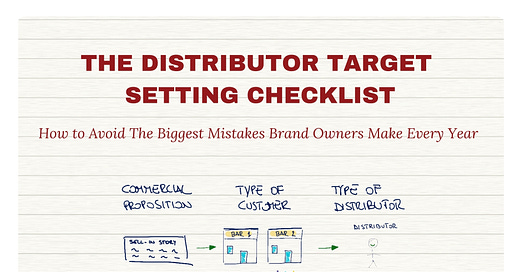The Distributor Target Setting Checklist
How to Avoid The Biggest Mistakes Brand Owners Make Every Year (That Leads To Painful Discussions and Expensive Divorces)
The MAFFEO DRINKS Guides is a bi-weekly email newsletter. With a systematized approach, it helps drink builders grow their brand from 10 to 10k cases. Each edition solves one clear challenge for subscribers. Some editions are free, and others are paid. Sign up here:
Dear Bottom-up Drinks Builder,
In today’s issue, I’ll review the 5 most common reasons drink brands struggle to manage their relationship with distributors. I'll show you my three 3-steps to set the foundations for a healthy relationship and brand growth.
By adopting this process, you’ll ensure you have solid basics before you even go into more detail.
Unfortunately, most brand owners underestimate how crucial target-setting is. They use it as a whip when they get it, making the relationship with distributors unbalanced.
Targets and KPIs should be used as a compass, not a whip. They tell you the direction but are useless if you don't know where you're heading.
I’ve had hundreds of meetings with distributors in 30+ markets across 4 continents. 99% of the time, one or more of these 5 challenges came up:
1. You haven’t agreed on targets and KPIs.
Agreeing on targets is tough. It's a painful chat to have, I get it. So why not procrastinate? We both want to sell "a lot" right? I've seen a lot of brands starting the discussion but then leaving it blurry and never managing to close it. Don't do that.
2. The targets you’ve set are wrong.
The second challenge is when both brand owners and distributors get overexcited. They agree on targets but they end up setting them too ambitious. I've seen a lot of hugs and toasts turning into blaming each other over underperformance.
3. You refuse to readjust targets to a new estimate.
This one is usually driven by the brand owner. Once that's clear that the brand is not going to reach its targets, owners keep pushing for it blindly. This demoralizes teams as they stop believing in it and they end up reaching even worse results.
4. You've agreed on targets but at the wrong pace.
This is the devil in the details. Often all is clear on paper but there's a misalignment between the parties. - the brand wants to accelerate during the same year. Since both parties need to contribute to the investments, the distributor refuses.- the distributor wants to milk the brand and go mainstream very fast.
They start using investments tactically. They started promoting the brand in the wrong places as they already had a premium portfolio. They needed a brand to cash in the upper-mainstream segment.
5. You've agreed on targets but not on clear KPIs.
Some brands think that setting the yearly volume target is everything. Once you know the end goal, you must track how to get there. Most brands measure KPIs quarterly but that is often too late as you have only 4 times a year to course-correct.
Sounds tragic? There's a way to fix that.
It's no silver bullet but if you put the effort into it, it will work.
Here’s the 3-step process I use.





